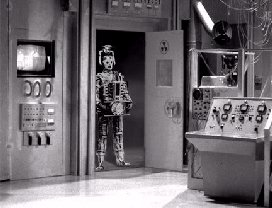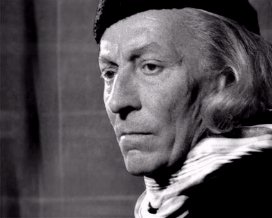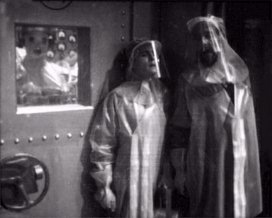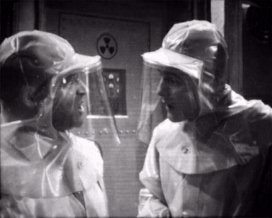 Ralph Montagu explains the methods he used to
reconstruct the episode: "When I first turned my
mind to doing a reconstruction of the Tenth Planet part 4, I was conscious that there
would be important differences between this exercise and the Ice Warriors. With the Ice
Warriors, I had all the telesnaps from episodes 2 and 3 to apply to just ten minutes of
sound track. With the Tenth Planet I would only be able to draw upon 60 or so usable
telesnaps for episode 4, with very few other stills existing in the BBC picture archive.
Ralph Montagu explains the methods he used to
reconstruct the episode: "When I first turned my
mind to doing a reconstruction of the Tenth Planet part 4, I was conscious that there
would be important differences between this exercise and the Ice Warriors. With the Ice
Warriors, I had all the telesnaps from episodes 2 and 3 to apply to just ten minutes of
sound track. With the Tenth Planet I would only be able to draw upon 60 or so usable
telesnaps for episode 4, with very few other stills existing in the BBC picture archive.Initially I intended to work to an edited sound track featuring the highlights, but had some difficulty deciding which bits to keep in and/or take out. I also needed to keep any scenes where the 8mm footage could be incorporated. So, I boldly decided to find, locate or create pictures for the whole episode.
 My first task was to scan the original contact sheets
featuring the telesnaps. I did this using a standard glass top scanner, which is more than
capable of capturing the resolution of these tiny prints. Amazingly, the line structure
shows through on these pictures, which is reassuring in so much as you know that there
wasn't much resolution lost in the process of taking photographs off the screen.
My first task was to scan the original contact sheets
featuring the telesnaps. I did this using a standard glass top scanner, which is more than
capable of capturing the resolution of these tiny prints. Amazingly, the line structure
shows through on these pictures, which is reassuring in so much as you know that there
wasn't much resolution lost in the process of taking photographs off the screen.Unfortunately, the contact sheets had been crudely stuck down to a piece of foolscap sized card, and several of the frames were smeared with the glue used any years ago. Other frames suffered from dirt and dust. I attempted to touch-out all these defects using Photoshop on my AppleMac. In doing so, I had to be careful not to obliterate the texture of the original line structure, although in some cases this was unavoidable. Once complete, I saved each picture for exporting to AVID, the non-linear system used for doing the 'rough assembly'.
 The next step was laying the telesnaps to the sound
track which had been cleaned up by Mark Ayes working from two sources. It quickly became
apparent that I would need to heavily supplement these with grabs from episodes 1 to 3,
and any other picture sources I could lay my hands on.
The next step was laying the telesnaps to the sound
track which had been cleaned up by Mark Ayes working from two sources. It quickly became
apparent that I would need to heavily supplement these with grabs from episodes 1 to 3,
and any other picture sources I could lay my hands on. My greatest difficulties arose with the scenes set in the Radiation Room. Ben and Barclay do not appear in radiation suits, or in this room, in any of the other episodes, and there are very few telesnaps of the Radiation Room scenes in episode 4. I therefore had to do a lot of Paintbox work putting their faces on the bodies of Cutler and the technicians in radiation suits. I was lucky to be able to supplement these with some pictures of the sets taken by the design department, loaned to me by Jan Vincent-Rudzki. The picture of the Radiation Room was especially useful and appears several times, albeit in different forms.
 In other parts of the episode, I was able to use publicity pictures which
fitted the action. This was particularly the case with the scene where the doctor leaves
the Cybership for the Tardis. It was clear from the script that the Doctor had donned his
hat and cloak. There aren't a lot of pictures featuring Hartnell wearing this combination,
but the few which do exist were put to good use!
In other parts of the episode, I was able to use publicity pictures which
fitted the action. This was particularly the case with the scene where the doctor leaves
the Cybership for the Tardis. It was clear from the script that the Doctor had donned his
hat and cloak. There aren't a lot of pictures featuring Hartnell wearing this combination,
but the few which do exist were put to good use!There were also several good pictures of the Cybermen in the snow outside the Polar Base, but it wasn't easy to use these as there aren't any such scenes in episode 4. However, I was able to cut out individual Cybermen and apply them to indoor scenes.
Where my source material was a large photographic print, I took the opportunity to put these under a rostrum camera, and record some moves and pans. It was possible to create a similar effect on the lower res telesnaps and grabs by making electronic zooms (using a Charisma Digital Video Effects generator), but this has to be done with care as too much zooming results in a pixilated image. Zooming in, or over, stills is one way in which an impression of fast action can be created; this was particularly useful where Cybermen fire their guns, or collapse under the effect of radiation.
 All the 8mm clips over about 1 second were incorporated. In placing them to the
right bit of the sound track, it was most helpful to have Rick Brindell's reconstruction
to refer to. However, getting the lips sync exactly right was a real fiddle. The original
footage was evidently shot on a camera with a variable speed motor, so we had to adjust
the speed of each clip separately to match the shot.
All the 8mm clips over about 1 second were incorporated. In placing them to the
right bit of the sound track, it was most helpful to have Rick Brindell's reconstruction
to refer to. However, getting the lips sync exactly right was a real fiddle. The original
footage was evidently shot on a camera with a variable speed motor, so we had to adjust
the speed of each clip separately to match the shot.As you would expect, the reconstruction starts with the reprise from episode 3 reprise and concludes with the famous clip from Blue Peter.
 The combination of such a diverse, and technically
different, mixture of stills has demanded very careful grading to get the texture and
contrast of each shot as similar as possible. But the most difficult part of the entire
project was simply finding pictures which really fitted the actions. Facial expressions,
cloths, background details, all had to be sufficiently consistent within a given scene to
give the impression of a seamless exchange between characters! I may have had three other
episodes to draw from , but finding the right shots of certain characters proved very
problematic, especially as I didn't want to use any one grab more than once. There will
always be scope for improvement, but in the end I had a deadline to meet.
The combination of such a diverse, and technically
different, mixture of stills has demanded very careful grading to get the texture and
contrast of each shot as similar as possible. But the most difficult part of the entire
project was simply finding pictures which really fitted the actions. Facial expressions,
cloths, background details, all had to be sufficiently consistent within a given scene to
give the impression of a seamless exchange between characters! I may have had three other
episodes to draw from , but finding the right shots of certain characters proved very
problematic, especially as I didn't want to use any one grab more than once. There will
always be scope for improvement, but in the end I had a deadline to meet.As with the Ice Warriors, the pictures do not appear full frame. A reduced size picture can help to conceal the inherently low quality and resolution of the material we are working with, and avoids any loss of image due to domestic television cut-off (remembering that the telesnaps have been subjected to this once already). The other point in favour of this treatment is that captions can run underneath the image area without interfering with the pictures. Not withstanding all this logic, some may feel that they would rather watch full frame pictures, and that the coloured backgrounds intended to emphasise each location are not necessary!
 When it came to it, I found that captions intended to
explain missing action were only necessary in a few places. As a result, the space for
captions at the base of the screen is rather under used, but it seemed pointless to add
more captions for the sake of it. When the video is released, I would welcome comments on
whether I did the right thing! I have retained a full frame recording of the finished
story, so that a future release could be altered if necessary. Of course if the
reconstruction were ever put on DVD, the captions could be turned on or off as an option.
When it came to it, I found that captions intended to
explain missing action were only necessary in a few places. As a result, the space for
captions at the base of the screen is rather under used, but it seemed pointless to add
more captions for the sake of it. When the video is released, I would welcome comments on
whether I did the right thing! I have retained a full frame recording of the finished
story, so that a future release could be altered if necessary. Of course if the
reconstruction were ever put on DVD, the captions could be turned on or off as an option.The opening and end titles were done on the 11th hour of the deadline day. The opening sequence is taken from other episodes, except the words 'EPISODE 4' which I created on my Mac. Unfortunately I used the wrong version of the writer's credit from episode 2, so Gerry Davis's name was accidently omitted. This appears to have been corrected by BBC Worldwide prior to duplication.
 The end titles were made up from scratch on my Mac
using the Eurostyle typeface, this included the scattered type effect which was created,
as it was originally, with just two alternating frames! The only difference is that the
original has a transition in which the centre lines of the type have vertical lines over
them, as if making a mix to the caption (actually it's a cut). I had intended to do the
same, but we hit a technical problem with this and we had to go with the basic two frame
version.
The end titles were made up from scratch on my Mac
using the Eurostyle typeface, this included the scattered type effect which was created,
as it was originally, with just two alternating frames! The only difference is that the
original has a transition in which the centre lines of the type have vertical lines over
them, as if making a mix to the caption (actually it's a cut). I had intended to do the
same, but we hit a technical problem with this and we had to go with the basic two frame
version.In conclusion, I have to say that whilst we would all be thrilled to see the rediscovery of the original episode 4, no one will appreciate the detail of the direction more than those of use who have done telesnap reconstructions, and tried to work it out for ourselves!"